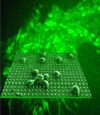
New Developments in Nano Safety
NIOSH Director Christine M. Branche, Ph.D., updated the safety and health community in March about her agency's nanotechnology activities. Writing in her "From the Director's Desk" column, Branche said nano research is increasing fast worldwide, and the National Science Foundation estimates nanotechnology will have a $1 trillion impact on the global economy by 2015 and will employ 2 million workers. One million of them may be in the United States, she wrote.
NIOSH set up its Nanotechnology Research Center five years ago to study nanotechnology's safety and health impacts and the potential applications of nanomaterials.
Recent NIOSH nano activities include presentation in March at a Society of Toxicology conference of preliminary findings indicating multi-walled carbon nanotubes pose health risks similar to the risks from asbestos exposure. NIOSH also published a series of articles in the Scandinavian Journal of Work, Environment & Health and the Journal of Occupational and Environmental Hygiene that was meant to provide a framework for occupational risk management of engineered nanoparticles. (The series of articles included "Sharpening the focus on occupational safety and health in nanotechnology" by NIOSH's Charles Geraci and others, Scand J Work Environ Health 2008;34(6):471-478, which is available here.)
New Reports and Guidance Documents
The agency also published interim guidance in February on medical screening and hazard surveillance for workers who may be exposed to engineered nanoparticles (Current Intelligence Bulletin 60, DHHS (NIOSH) Publication No. 2009-116).
Branche cited two important new reports, saying one of them, "Approaches to Safe Nanotechnology: Managing the Health and Safety Concerns Associated with Engineered Nanomaterials" (DHHS (NIOSH) Publication No. 2009-125, March 2009) "has received global recognition for its scientific contribution to identifying and addressing key risk management issues in the field of nanotechnology, including recent citation by the U.S. Environmental Protection Agency and the International Organization for Standardization."
The second report is "Progress Toward Safe Nanotechnology in the Workplace" (NIOSH Publication No. 2007-123).
"Over the past five years, NIOSH has made great strides in advancing the scientific knowledge of nanomaterials," Branche wrote. "We have found that these materials, which have novel characteristics unlike larger particles, may present new challenges to understanding, predicting, and managing potential health risks to workers. Still, many knowledge gaps remain to be filled before we fully understand whether new safeguards are needed in the workplace to ensure safe handling of nanomaterials. Through strategic planning, research, partnering with others, and making information widely available, NIOSH is working in parallel with the development and implementation of nanotechnology and will be better able to anticipate challenges and provide sound scientific recommendations to prevent work-related illness and injury."
Any company interested in participating in NIOSH's field investigation program should contact Chuck Geraci ([email protected]). For partnership opportunities in nanotoxicology, contact Vince Castranova ([email protected]). Additional information about NIOSH nano research is available here.